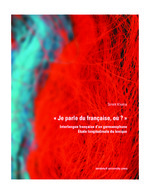« Je parle du française, où ? » Interlangue française d’un germanophone Étude longitudinale du lexique
Author(s)
Khatra, Simrit
Collection
AG UniversitätsverlageLanguage
FrenchAbstract
How to talk when you learn a foreign language? The language of the learner does not match from the beginning of the target language, it is characterized by numerous "errors" that are partially pre-programmed by the interference of the mother tongue. This language can be used as interlangue (Lerner Language) - a language between the target language and the mother tongue - are referred to. Empirical research on learner language are still not very present in linguistics, especially in the area of lexis. The theme of this work is the presentation of the development of interlangue a germano-speaking Austrian student during his four years of learning French as a foreign language. Wie spricht man, wenn man eine Fremdsprache lernt? Die Sprache der Lernenden entspricht nicht von Anfang an der Zielsprache, sie ist durch zahlreiche „Fehler“ geprägt, die teilweise durch die Interferenz der Muttersprache vorprogrammiert sind. Diese Sprache kann als interlangue (Lernersprache) – eine Sprache zwischen der Zielsprache und der Muttersprache – bezeichnet werden. Empirische Forschungen über die Lernersprache sind nach wie vor in der Linguistik vor allem im Bereich der Lexik wenig vorhanden. Das Thema der vorliegenden Arbeit ist die Darstellung der Entwicklung der interlangue eines germanophonen österreichischen Schülers während seiner vier Lernjahre in Französisch als Fremdsprache. Quand on apprend une langue étrangère, que parle-t-on ? La langue des apprenants ne correspond pas dès le début à la langue cible, mais elle est pleine de « fautes » partiellement « programmées » par l‘interférence de la langue maternelle. C‘est une véritable interlangue – une langue entre la langue cible et la langue maternelle.
La recherche empirique linguistique sur l’interlangue est encore insuffisante, tout particulièrement dans le domaine du lexique.
Le sujet de la présente étude est l‘évolution de l‘interlangue d‘un élève autrichien germanophone pendant ses quatre années d’apprentissage scolaire du français langue étrangère. En analysant la totalité de sa production langagière française écrite pendant ces quatre années, on comprendra le développement de son interlangue au niveau du lexique : l‘évolution de ses fautes lexicales (leur répétition, leur modification, leur disparition et leur persistance dans certains cas), mais aussi l‘utilisation correcte du vocabulaire appris. L‘analyse est complétée par un carnet de statistiques qui montre de façon impressionnante comment augmente d‘année en année le contenu du lexique mental bilingue et comment évolue la relation entre le vocabulaire appris et le vocabulaire utilisé, de même que la relation entre le vocabulaire utilisé de manière correcte et celui utilisé de manière fautive.
La méthodologie choisie d‘une étude longitudinale permet de montrer la dimension dynamique de l‘interlangue, tout cela dans un domaine crucial de l‘apprentissage d‘une langue étrangère – le lexique.
Keywords
fehler; französischunterricht; lernersprache; french lessons; mistakesDOI
10.26530/OAPEN_483301ISBN
9783902936202OCN
952619456Publisher
innsbruck university pressPublisher website
https://www.uibk.ac.at/iupPublication date and place
2013Series
Studien des Interdisziplinären Frankreich-Schwerpunkts der Universität Innsbruck, 8Classification
Language acquisition
Language teaching and learning
Language teaching theory and methods


 Download
Download Web Shop
Web Shop